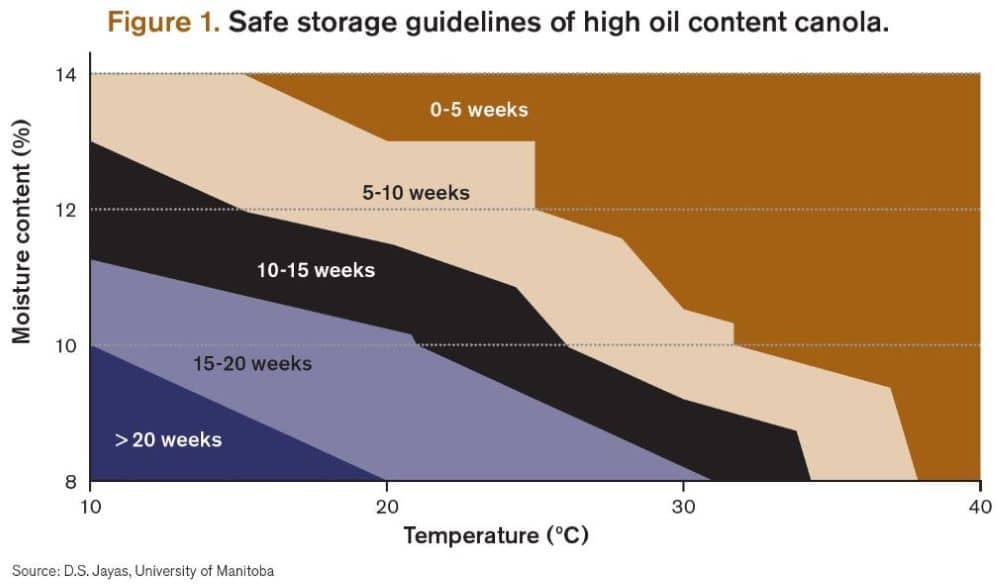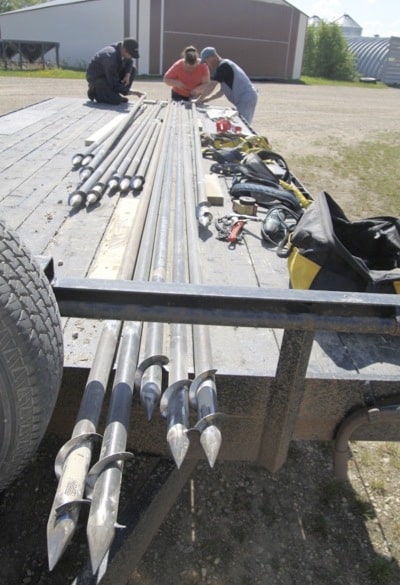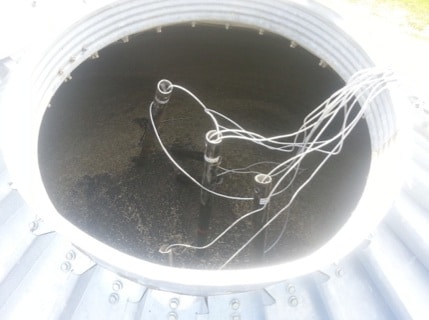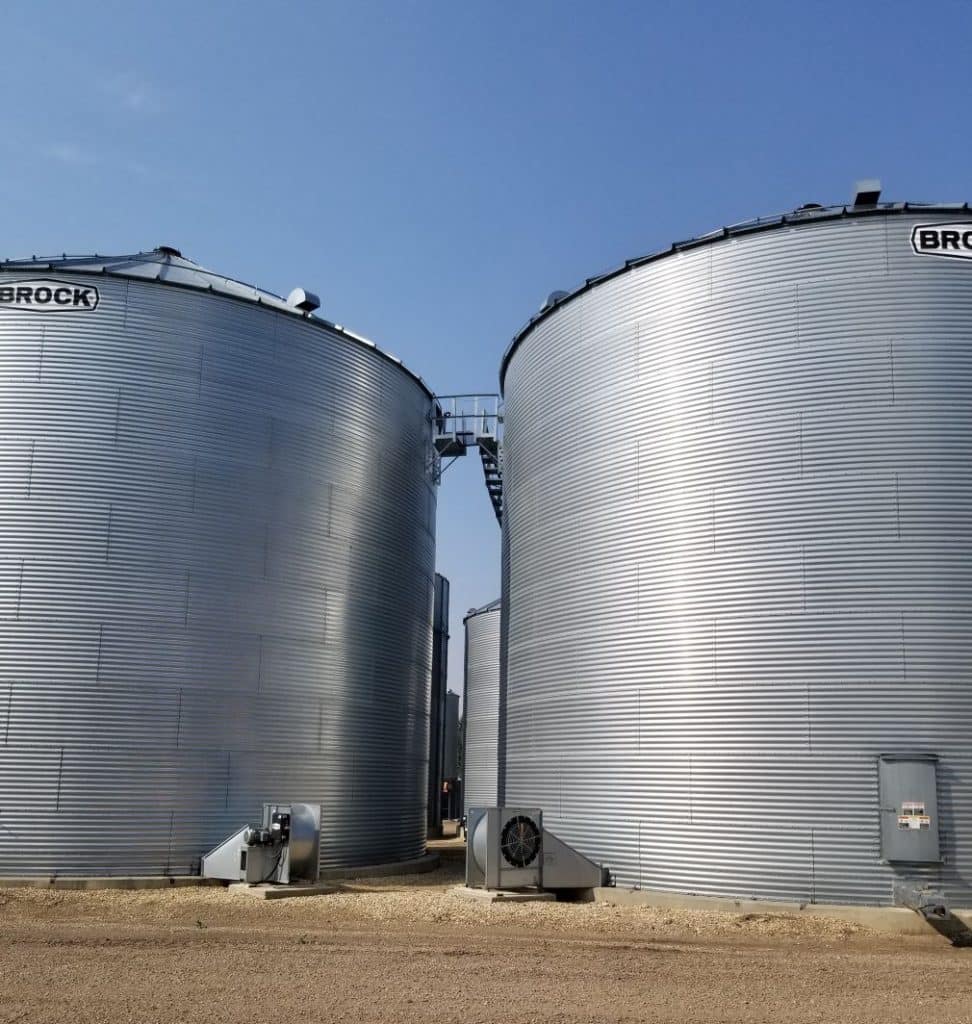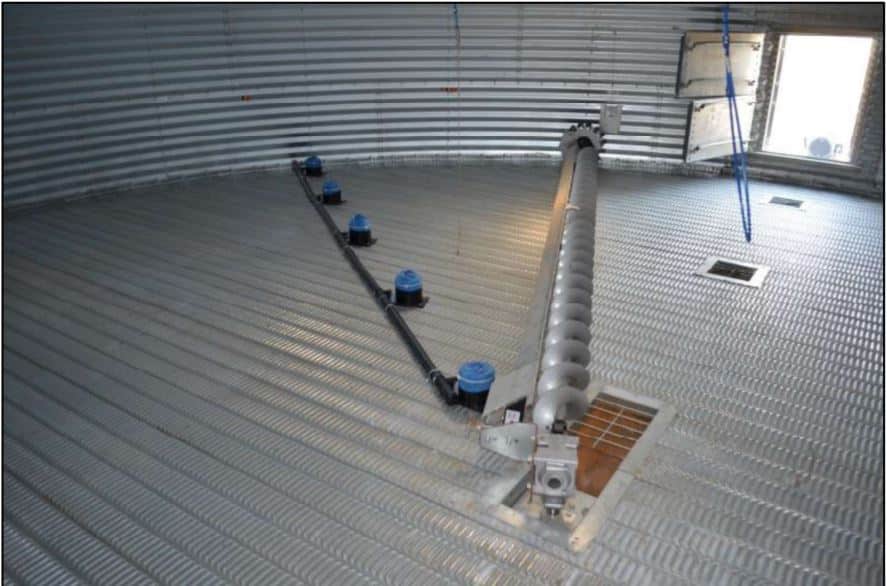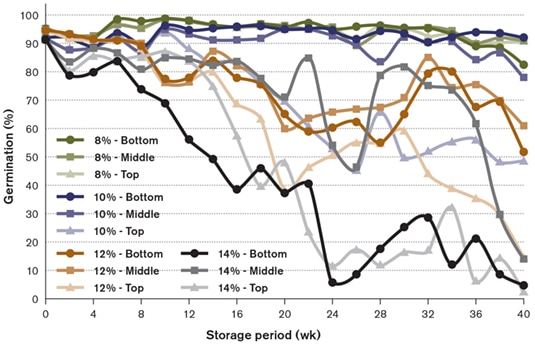Safely storing harvested canola is critical to maintaining seed quality until it can be delivered. Several risk factors can be considered for the type and size of storage options and equipment that a grower has, as well as the logistics of the operation and the amount of time that the grain will be stored for. The research referenced below covers different aspects of these topics in order to offer the best recommendations for successfully storing canola.
Canola oil content as storage factor
High temperatures across the Prairies throughout the 2021 growing season may not have favoured high oil content (concentrations), but Jayas’ research out of the University of Manitoba provides results on both low (less than 42.5 per cent) and high (about 45 per cent) oil content samples. Since the Canadian Grain Commission’s Preliminary 2021 quality data of eastern and western Canadian canola reports minimum, maximum and mean values of 34.2, 46.6 and 41.2 per cent oil content, respectively (8.5 per cent moisture basis) in the Canola, No. 1 Canada samples, there may be some growers with grain samples at either end of this range.
This project, titled ‘Storage and handling characteristics of new varieties of high oil content canola’ included three different experiments: one on small-scale storage, one on large-scale storage, and one on physical properties.
- The small-scale study compared high oil canola and a standard canola variety (cultivar) stored in 20 litre plastic pails at eight, 10, 12, and 14 per cent moisture content inside environmental chambers at 10°C, 20°C, 30°C and 40°C for up to five months. Samples were removed from the containers every two weeks and tested for germination rate, visible mould, and free fatty acid values.
- Only canola with 14 per cent moisture had a considerable decrease in germination rate after 10 weeks of 20°C. Germination rate of both high oil and standard canola varieties stored at 30°C and 40°C, decreased significantly in a short time.
- Mould was evident in some high oil content varieties with greater moisture content stored at higher temperatures.
- In the large-bin study, canola was loaded into three flat bottom bins inside an environment-controlled room and was initially aerated with humid air to bring the seed moisture content to 10 per cent.
- Six weeks in, visible mould appeared in the top layers of the three bins, and after 10 weeks, one bin had visible mould at all layers.
- After 16 weeks, germination rates for canola in the top layer of all three bins decreased by more than 20 per cent.
- The physical properties study reported bulk densities of both varieties increased with moisture contents from eight to 10 per cent and decreased from moisture contents of 10 to 14 per cent. However, the bulk density of high oil content canola was more affected by the difference in moisture content than low oil content.
- As well, storage infrastructure that are strong enough for low oil content canola can also be used to store canola with higher oil content.
For more details on this study and a video of the lead researcher discussing canola storage research, see the project summary page.
Seasonal impacts on storage recommendations
Agnew’s one-year Determining best practices for summer storage of canola in Western Canada (part 1) project out of the Prairie Agricultural Machinery Institute (PAMI) measured grain temperature, relative humidity and airflow rates on three 4,000-bushel, 18-foot diameter bins of canola which utilized three different management practices — aeration, grain turning and leaving it alone. Two of the bins were monitored throughout June and July, and data was collected on the other bin until the end of November. Some findings from this project include:
Grain temperature and humidity trends:
- There was little moisture migration in all three bins through June and July, and spoilage or condensation was negligible. However, this may have been partially due to the low moisture content (six per cent) of the canola used.
- There were large temperature differences in each bin. The baseline bin was 25°C at the edge and -3°C in the core for most of July.
- There was no noticeable difference in the grain temperature on the ‘sunny side’ of the bin versus the ‘shady side’ of the bin.
- The temperature in the bin headspace fluctuated from day to night (up to 55°C) when the relative humidity was low (<40 per cent). The temperature of the grain at the top of the bin (within two feet of headspace) did not fluctuate during the day.
Impacts of turning and aerating:
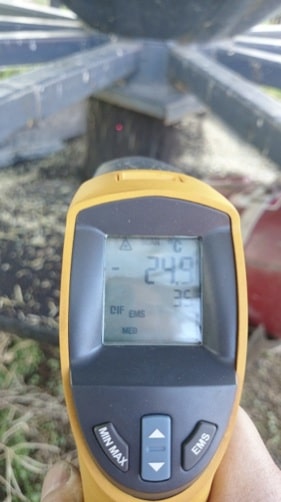
- Turning the seed (700 bushels in a 4,000-bushel bin) initially resulted in a relatively warm core and warm edges but cool seed between the core and edges. This temperature differential eventually evened out (the core cooled through June).
- Aerating the seed resulted in a uniform temperature distribution (approximately 20°C), but the transition between the warming front and the cool seed resulted in unstable in-bin conditions (potential for condensation).
- Aerating the seed using warm summer air added a large quantity of moisture to air voids in the bin (as measured by absolute humidity). However, this moisture was not transferred to the grain since the moisture content of the stored canola did not change (6.6 per cent at the start of monitoring and 6.5 per cent three weeks after aeration was completed).
- The turned bin and aerated bin had unstable conditions (from in warm seed being directly adjacent to cool seed) in July that could have possibly resulted in spoilage, but didn’t.
- The aerated bin the warming front moved through the cool seed.
- In the turned bin, the warm seed at the top funneled down into the center of the bin during turning, leaving a warm core adjacent to cool seed.
- The unturned bin had the lowest storage risk that summer.
- The warming rate of canola is approximately equal to the cooling rate at aeration flowrates of 0.1 to 0.5 cfm/bu), as it took ~48 hours to uniformly warm the canola in a 4,000-bushel bin using 0.75 cfm/bu.
The results from this project were useful and interesting, but are limited to dry canola (six per cent moisture) that was frozen over winter. If the stored canola has a higher moisture content or different starting temperature, the degree of moisture migration may be different over the summer months, which can increase the risk of spoilage or heating.
As winter transitions into summer, it is recommended to monitor the temperature profile in canola bins for rapid increases which can indicate spoilage and have a plan in place to move the grain if this occurs and not to turn or aerate. As well, aerating and turning grain to warm up canola stored throughout the cold western Canadian winter is not necessary.
For more information on this study, check out the final report.
Summer storage research for canola
Due to a strong interest in the summer or longer term storage recommendations for canola with higher moisture content, Agnew’s subsequent ‘Determining best practices for summer storage of canola in Western Canada (part 2)’ study, utilized canola with nine per cent moisture content.
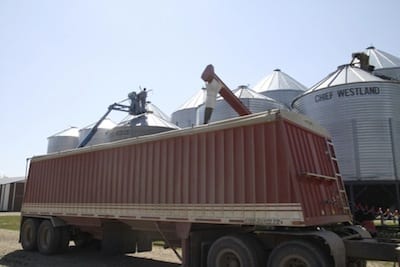
The temperature profile in three 3,500-bushel bins was monitored throughout the summer (from June to August) in 2016. One bin was left alone (not turned or aerated), one bin was aerated to even out the temperature distribution, and one bin was turned to even out the temperature distribution. Other bins of varying size were intermittently monitored throughout the summer. This study reported:
- Turning the bin at the beginning of June resulted in the lowest average bin temperature at the end of the monitoring period, while aerating in June resulted in the most uniform temperature distribution.
- Both turning and aeration resulted in unstable conditions for a short period of time that may have resulted in condensation in the grain.
- Both turning and aerating helped to equalize temperature distribution, but both created regions where cold grain was directly adjacent to warm grain for short durations. This resulted in potentially unstable conditions that can increase the risk of spoilage.
- Leaving bins alone resulted in the most stable and favourable storage conditions throughout the summer months, provided the canola is dry (<10 per cent moisture content) and uniformly frozen (to less than -5°C) going into the spring months.
- Although one of the intermittently monitored bins had a much higher starting temperature in May and maintained stable conditions until August, this single instance is not enough to expand the recommendation to all starting conditions.
- Canola should be monitored frequently when it is stored to minimize the risk of grain spoilage.
Natural air drying and supplemental heating recommendations
The following year Agnew and Sprenger also conducted a study on ‘Defining best management practices for using supplemental heating with natural air drying’ which included two trials. One trial compared the effect of air flow rate on supplemental heating with natural air drying (NAD) compared to NAD without added heat, using bench-scale test bins, and the subsequent trial assessed the rate of drying with supplemental heat at three different temperature increases.
All trials were planned to occur in mid-late fall to ensure the ambient environmental conditions were representative of when supplemental heating is typically used. Moisture content, seed weights, and grain temperature data from each bin were recorded for the six treatments.
- The results reported that increasing the temperature of grain drying by 10°C when ambient environmental conditions were cool and damp increased the drying rate, when the airflow rate was at a minimum of one cubic foot per minute per bushel (cfm/bu).
- It was also noted that airflow rate has an impact on drying rate, particularly for wetter grain. Airflow rate will depend on the type of fan used, the density of the grain and grain depth within the bin. (If airflow is too low, consider removing some grain from the bin.)
- Over-drying the bottom of the bin may not be avoidable, therefore an average dry moisture should be targeted, followed by mixing the grain.
- The second trial reported that a 10°C increase in temperature supplied by supplemental heat was adequate when the plenum temperature was greater than five degrees Celsius. However, if sub-zero ambient conditions are experienced for prolonged periods of time, higher temperature increases will be required.
- Based on the observed rates of drying for both canola and wheat in these trials, supplemental heating with a NAD system may not be suitable for starting grain moisture contents more than three percentage points above “dry” because an increased risk of spoilage is possible. Careful monitoring or reduced grain bed depths can help mitigate this risk if a heated-air dryer is not available.
- An economic assessment of supplemental heating with various fuel types found that the type of fuel has the greatest impact on operating costs.
- Natural gas had lower cost than diesel and propane, however, access to natural gas can be capitally hindering in certain regions. Estimated efficiencies for NAD systems with supplemental heat ranged from 50 to 75 per cent compared to efficiencies of 40 to 55 per cent for the dedicated heated-air drying systems.
Additional information on this research and a link to project summary can be found here.
Canola storage in large bins
An additional storage project titled ‘On-farm canola storage research in large bins‘ conducted by PAMI and led by Grieger investigated large bins and the effects of a “peaked” vs. “spread” bin filling system on grain distribution, to measure airflow rates and static pressures from common aeration fans, to airflow uniformity, and grain pressure distribution on the bin floor.
The initial trial monitored canola conditioning with a peaked center, which was created by loading canola into the center of the bin directly from an auger. The second trial emptied the partially conditioned canola into a second 25,000-bushel bin to equalize the grain temperature and refilled the first bin using a gravity driven spreader to produce a more level grain surface. Key findings from this research included:
- Centrifugal fans rated for 10 hp centrifugal fans available for single phase power were not adequate to provide the required static pressure and airflow to condition canola in a 25,000-bushel bin. After filling to ~17,000 bushels (70 per cent full) in a 25,000-bushel bin, two 10 hp centrifugal fans operating in parallel reached their ‘stall’ static pressure and a single 10 hp centrifugal fan was nearing its stall static pressure.
- The conventional method of comparing air distribution by observing the relative temperature ‘front’ movement was not suitable because of the many variable conditions, so temperature change ratios between the ambient temperature, and the initial and final grain temperatures were used instead. These ratios revealed no clear indication that a gravity spreader provided any airflow benefits.
- Although the grain pressure measurements did not provide a mathematical relationship among the five sensors installed at different distances from the bin center, the vertical load steadily increased with grain depth as expected but the sensors indicated a higher vertical force near the center for the peaked trial and a higher vertical force about 10 feet away from the center for the spread trial.
- The average load per grain depth suggested that the spreader increased the overall grain density.
- In a partially filled bin, the gravity spreader provided a marginal benefit in grain surface distribution (as it did not produce a level grain surface), a small decrease in airflow rate, no differences in the airflow uniformity, and an increased grain density when storing canola.
Overall, the previous airflow/static pressure recommendations developed from small bins are effective in conditioning canola for safe long term (over five months) canola storage. However, the fan requirements and grain monitoring practices may need to be adapted for larger bins.
For details on the results which led to these conclusions, see the comprehensive final report.
Bag storage systems for canola
Although fewer growers may need extra storage this year, some interesting information has been found by Jayas on bag storage.
Check out these studies for more information:
- Feasibility of bag storage system for canola under Prairie conditions (part 1)
- Feasibility of bag storage systems for canola storage under Prairie conditions (part 2)
Canola storage resources
For related canola storage knowledge and some grower recommendations, check out these resources:
- Canola Digest: Storage risk article
- Canola storage podcast
- Canola Watch: Canola storage video
- Keep it Clean: Canola storage reminder
- Canola Watch: Harvest and storage fundamentals
- Canola Council of Canada’s (CCC) Canola Encyclopedia: Storage entry
- CCC’s Canola Storage guide
- Safe grain storage interview, featuring CCC agronomy specialist Shawn Senko and researcher Lorne Grieger
For other harvest content, check out the previous Canola Research Hub blog: Make the most of canola yields by minimizing losses at harvest.
For other harvest-related research, check out these interesting projects on the Canola Research Hub:
- Developing Brassica napus lines with reduced pod shattering
- Evaluation of harvest losses and their causes in canola across Western Canada
- Developing methods to estimate pod drop and pod shatter in canola
- Pre-harvest herbicide and desiccation options for straight-combining canola: Effects on crop dry-down and seed quality
- On-farm survey of combine grain loss in canola across Western Canada
Published September 17, 2021


